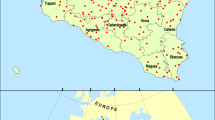Abstract
The fluted pumpkin (Telfairia occidentalis), an important cucurbitaceous leaf and seed vegetable, is indigenous to the west tropical rainforest area from Bendel to Cross Rivers states of Nigeria (c. longitude 7°–8° E and latitude 5°–6° N). Though endemic to southeastern Nigeria, Telfairia is of local ethnobotanical importance in the folklore and the dietary and cropping systems of Igbos and their neighbours. There is no reported definitive ethnobotanical study relating to this cucurbit.Telfairia has long been important in the internal food trade of Igbos. Like other leaf vegetables, it is of low commerical value, but can in some cases provide an appreciable cash income to small farm families. Its leaves, succulent shoots, and seed kernels constitute the usual ingredients that are popular and regularly consumed in Igbo soups. Soups made of leaf vegetables are essential for consumption of starchy pastes of yam, cassava, or cocoyam, which are frequently consumed in the humid areas of Nigeria. Many good attributes account for the increasing importance of this chief vegetable among 30–35 million people in Nigeria.
Similar content being viewed by others
Literature Cited
Achebe, C. 1958. Things fall apart. Heinemann, London.
Akoroda, M. O. 1986. Seed dessication and recalcitrance inTelfairia occidentalis. Seed Sci. & Technol. 14:327–332.
Akubue, P. I., A. Kar, and F. N. Nnachetta. 1980. Toxicity of extracts of roots and leaves ofTelfairia occidentalis. PI. Med. 38:339–343.
Burkill, H. M. 1985. The useful plants of West Tropical Africa. 2nd ed. Vol. 1. Royal Botanic Gardens, Kew.
Floyd, B. 1969. Eastern Nigeria: a geographical review. Macmillan, London.
Ifemesia, C. 1979. Traditional humane living among the Igbo: an historical perspective. Fourth Dimension, Enugu, Nigeria.
Isichei, E. 1976. A history of the Igbo people. Macmillan, London.
Keay, R. W. J., ed. 1954.Telfairia. Pages 210-211in Flora of West Tropical Africa. Crown Agents for Overseas Governments Administrations, London.
Longe, O. G., G. O. Farinu, and B. L. Fetuga. 1983. Nutritional value of fluted pumpkin. J. Agric. FoodChem. 31:989–992.
Morgan, W. B. 1955. Farming practice, settlement pattern and population density in south-eastern Nigeria. Geogr. J. 121:320–333.
Okafor, J. C. 1979. Edible indigenous woody plants in the rural economy of the Nigerian forest zone. Pages 262-300in D. U. U. Okali, ed., The Nigerian rainforest ecosystem. Man and the Biosphere National Committee. Fed. Min. Sci. & Techn., Ibadan, Nigeria.
Okigbo, B. N. 1977. Neglected plants of horticultural and nutritional importance in traditional farming systems of tropical Africa. Acta Hort. 53:131–150.
—. 1980. Plants and food in Igbo culture and civilization (1980 Ahiajoku Lecture). Ministry of Information, Culture, Youth and Sports, Owerri, Nigeria.
Oliver, D., ed. 1871. Flora of Tropical Africa. Vol 2. L. Reeve, London.
Oyolu, C. 1978. Relatively unknown vegetable: fluted pumpkin (Telfairia occidentalis). Proc. 1st Ann. Conf. Hort. Soc. Nigeria. NIHORT, Ibadan, Nigeria.
Poppleton, W. J. 1939. The Oyster nut-Telfairia pedata. E. African Agric. J. 15:114–120.
Purseglove, J. W. 1965. The spread of tropical crops. Pages 375–389in H. G. Baker and G. L. Stebbins, eds., The genetics of colonizing species. Academic Press, New York.
Sai, F. 1965. Nutritional value of West African fruits and vegetables. Pages 5–14in H. D. Tindall, Fruits and vegetables in West Africa. Food and Agriculture Organisation, Rome.
Stebbins, G. L. 1950. Variation and evolution in plants. Columbia Univ. Press, New York.
Talbot, P. A. 1967. Tribes of the Niger Delta. Frank Cass, London.
—, and H. Mulhall. 1962. The physical anthropology of Southern Nigeria, Cambridge Univ. Press, Cambridge.
Uchendu, V. C. 1965. The Igbo of Southeast Nigeria. Holt, Rinehart and Winston, New York.
Ukwu, U. I. 1969. Markets in Igboland. Pages 113–254in B. W. Hodder and U. I. Ukwu, Markets in West Africa. Ibadan Univ. Press, Ibadan, Nigeria.
Walker, J. 1985. Compound farming systems of southeastern Nigeria (Interim Report). Socio-Economic Unit, 11TA, Ibadan, Nigeria.
Author information
Authors and Affiliations
Rights and permissions
About this article
Cite this article
Akoroda, M.O. Ethnobotany ofTelfairia occidentalis (cucurbitaceae) among Igbos of Nigeria. Econ Bot 44, 29–39 (1990). https://doi.org/10.1007/BF02861064
Received:
Accepted:
Published:
Issue Date:
DOI: https://doi.org/10.1007/BF02861064




